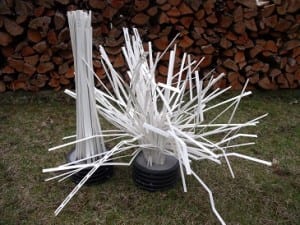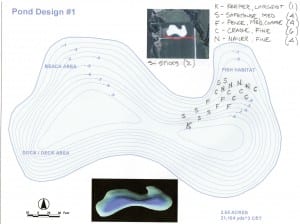THREE RIVERS AREA — The roar of a bulldozer on the banks of Mill Creek alerted residents in Izard County that their lives were about to change dramatically.
In February 2008, landowner George Bartmess stripped most of the vegetation from the creek bank on his property. He even plowed up some of the creek bed. Heavy rains washed sand and silt into the creek and downstream into Piney Creek. Piney’s gravel creek bed filled with sand and mud, threatening the smallmouth-bass habitat.
Barbara Carlson, who lives nearby, said Bartmess’ actions got the attention of his neighbors.
“Local people didn’t know Bartmess was planning to do sand mining,” Carlson said. “We came together and asked Friends of the North Fork and White River to help us understand the laws and environmental problems.”
The Friends helped residents form a chapter, Friends of Mill and Piney Creeks. Members of the new organization spent months studying frac sand mining, state and federal laws, and the permitting process.
They learned that B&H Resources LLC of Shreveport, La., had applied to the Arkansas Department of Environmental Quality for a quarry sand-mining permit. Beneath southern Izard County are thousands of tons of high-grade silica sand. Today, it is in demand as “frac sand,” used to help release natural gas from gas shale.
“We realized what Bartmess was doing was illegal,” Carlson said. “He was allowed to do nothing until his permit was approved.”
The group informed the ADEQ of Bartmess’ activity, and the department issued an emergency “cease and desist” order on June 19, 2008. Responding to the Mill and Piney Creeks group’s complaints, the Arkansas Game and Fish Commission ordered B&H to repair damages along Mill Creek.
“A small group became active,” Carlson said. “We tried to educate the public and publicize what was happening. Word was spreading. People were alarmed.”
Company owner Mike Hardy was the “H” in B&H. Bartmess was the “B.”
“After the cease-and-desist order, we had issues with Bartmess,” Hardy said. “We bought him out and reorganized as Evergreen Processing LLC. We had to start the permit process all over. We have voluntarily held public meetings since we began the permitting process.”
About 130 local residents attended a meeting on Oct. 5, 2009, at the Calico Rock Music Hall. Evergreen sent its consultants to outline plans for the 1,300-acre mining site. Engineer Dan Drinkwater said the quarry would cover about 300 acres. To wash the sand, the plant would use about 390,000 gallons of water a day, drawn from 2,000-foot-deep wells.
Concerned that using so much water would dry up homeowners’ wells, Friends of Mill and Piney Creeks invited John Czarnecki of the U.S. Geological Survey to a public meeting on Feb. 18, 2010, in Calico Rock. Czarnecki said the volume of the Ozark Aquifer, which flows beneath northern Arkansas, has never been measured for Izard County, so it is not known if there is enough water to support sand-mining operations.
Hardy said after the meeting that he asked his consultant geologist, David Williamson, to meet with Czarnecki to investigate the dynamics of the aquifer.
“We have 18 springs on the Evergreen property,” Hardy said. “The second-largest spring runs well and has about the same flow in wet and dry years. We asked the Arkansas Natural Resource Commission to look at the spring, and they felt it was a better fit. It will cost us more to build a five-mile-long pipeline with four pumps to move the water from the spring to the plant, plus yearly maintenance. We made the change because it just made sense.”
At the October 2009 meeting, Evergreen consultant Kevin Ware said that after the sand is washed, the water will be pumped into retention ponds. Polyacrylamide would be added to bind with the sediment and make it sink. Some of the “clean water” would be reused. However, an ADEQ permit allows the release of “clean water” into creeks that eventually flow into the White River.
Jeff Williams, trout biologist for Arkansas Game and Fish, spoke next. He said trout become stressed when temperature, turbidity, chemicals and/or sediment levels of river water change. The fish don’t feed or spawn well and are more likely to die.
Responding to these concerns, Evergreen redrew its plans over the next year.
Hardy said the new plan does not use sediment-binding chemicals.
“We will bring water into a slurry, which presses the sediment into clay bricks,” he said. “The used water will go into two ponds, 4 acres each, with a berm around them.”
The bricks will be used to refill the quarry.
Evergreen will also use much less water.
“We will draw water from the ponds back into the plant, only adding water for condensation and evaporation,” Hardy said. “When we start this plant, we will become part of this community. Questions and concerns from meetings quickened our decision to make some changes. We felt the changes would have less impact and be more sustainable.”
On Jan. 25, ADEQ held a public hearing at Calico Rock City Hall on Evergreen’s discharge and pond-construction permit. The company’s revised plan includes using spring water and storm water and only cutting trees and vegetation for roads, the quarry and the plant.
More than 60 people attended the hearing. In response to questions from the audience, Mo Shafii, ADEQ Water Division assistant chief, said the department, which is responsible for 6,000 permits and has only 15 inspectors, is only required to inspect a permit site once every five years.
“Permits are a self-policing system,” Shafii said.
However, the agency usually responds to complaints from the public within three days, Shafii.
According to media reports, in March, Evergreen completed planting 15,000 river birch, silver maple, sycamore and red oak seedlings and a variety of shrubs as part of the rehabilitation plan that Game and Fish ordered along Mill Creek.
Carlson said local residents will have to monitor what the plant discharges into the streams near the quarry.
“We have been effective because we approached all that was happening with calmness and rationality, asking how we could minimize the impact of sand mining,” Carlson said. “My feeling is, let’s try to protect the environment on the front end, so we won’t have to fix it on the back end.”
Kenneth Ballman, justice of the peace from Horseshoe Bend, also has concerns about Evergreen and the other two frac sand-mining operations in Izard County.
“Sand mining will contribute to the local economy,” Ballman said. “At Guion, 30 to 35 jobs; Evergreen, 30 to 35 jobs. Short-term, this will be good for our economy, but the long-term impact could be worse. I would like to see a study of the aquifer.”








 DRIFTLESS FARM (PHOTO BY UW-STEVENS POINT)
DRIFTLESS FARM (PHOTO BY UW-STEVENS POINT)  DRIFTLESS AREA (BY NATIONALATLAS.GOV)
DRIFTLESS AREA (BY NATIONALATLAS.GOV)